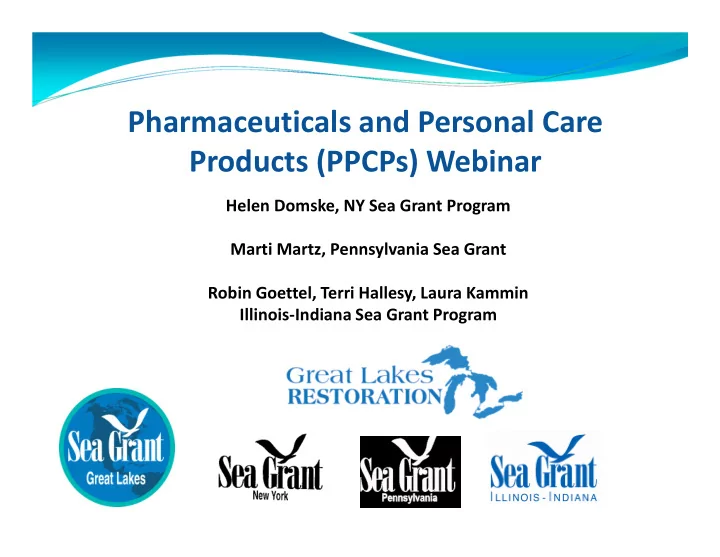

Pharmaceuticals and Personal Care Products (PPCPs) Webinar Helen Domske, NY Sea Grant Program Marti Martz, Pennsylvania Sea Grant Robin Goettel, Terri Hallesy, Laura Kammin Illinois-Indiana Sea Grant Program
What is Sea Grant? The National Sea Grant College Program includes 32 state Sea Grant programs located in every coastal and Great Lakes state and Puerto Rico. Administered by NOAA, Sea Grant focuses on environmental and economic issues in coastal communities. Focus Areas: � Sustainable coastal development � Healthy coastal ecosystems � Safe and sustainable seafood supply � Hazard resilient coastal communities
Pharmaceuticals and Personal Care Products (PPCPs) • Includes prescription and over-the-counter medications, cleaning agents, cosmetics, nutritional supplements and skin care products • Produced and used in larger volumes yearly • Biologically active
Main Risks of Improper Disposal Practices Environmental impact • Accumulation in waterways leads to concern about continuous, multigenerational exposure to wildlife Accidental ingestion • Between 2004 and 2005, an estimated 71,000 children (<18 years of age) were seen in Emergency Treatment Facilities each year because of medication poisonings (excluding abuse and recreational drug use). Illegal use or theft A survey of teens found that 62% who abuse prescription pain relievers said they do so because • they are easily accessible through parents’ medicine cabinets. Unnecessary waste of healthcare dollars
How PPCPs Get Into The Environment
“What Goes Around…” Pharmaceuticals Drugs Gastrointestinal tract conjugation Liver Blood Kidneys Bile Feces Urine Our liver detoxifies chemical substances by a series of chemical reactions, making many substances more water soluble so they can be eliminated. Credit: Dr. James Jensen, University at Buffalo
Chemicals in Drinking Water These 12 pharmaceutical chemicals show up most in contaminated drinking water: Most are estrogenic hormones (8), the 9 th is another hormone, progesterone, and the 10 th is the antibiotic erythromycin. Source: 7 Scary Facts About Pharmaceutical Pollution of Drinking Water By Jim Edwards
Environmental Impacts ��������������������������������������������������� ����������������������������������������������� �����������������������������������
Medicines in the Environment U.S. Geological Survey monitoring study • 139 streams were analyzed in 30 states • Contaminants identified in 80% of these streams • 82 contaminants identified (many were pharmaceuticals) • Co-occurrence common; average 7 distinct contaminants were identified per stream Kolpin, D.W. et al. 2002. “Pharmaceuticals, hormones, & other organic wastewater contaminants in U.S. streams, 1999- 2000: A national reconnaissance.” Environmental Science & Technology. 36(6):1202-1211.
Medicines in the Environment USGS/CDCP Study of Drinking Water Facility • Analyzed for 106 contaminants in 24 water samples from locations within a drinking-water-treatment facility and the 2 streams serving the facility • 40 contaminants detected in 1 or more samples of stream water or raw-water supplies in the plant • 34 contaminants detected in >10% of these samples • Some prescription and non-prescription drugs and their metabolites were detected in finished water Stackleberg, P.E. et al. 2004. “Persistence of pharmaceutical compounds and other organic wastewater contaminants in a conventional drinking-water-treatment plant.” Science of the Total Environment. 329:99-113.
Effects on Aquatic Organisms: Cause for Concern • Aquatic exposure – chemicals in the aquatic environment can result in continuous, multigeneration exposure. • Feminization of fish - link to estrogen exposure? Ex: Boulder Creek, CO: female white suckers outnumber males by > 5 to 1; 50% of males have female sex tissue (David Norris, Univ. of Colorado at Boulder) • Effects of antidepressants on fish and frog development? Ex: Lab studies show low levels of common anti-depressants, including Prozac, Zoloft, Paxil and Celexa, cause development problems in fish, and metamorphosis delays in frogs (Marsha Black, Univ. of Georgia)
Effects on Aquatic Organisms: Cause for Concern • Lake Michigan studies show that antibiotics, caffeine, mood-stabilizing drugs, pain relievers, and antibacterials were found in the lake. • 2010 Study found chemical compounds “practically everywhere in Lake Michigan (Thomas Lauer, Ball State University) “To get large, measurable numbers – consistently – all those places (along the shoreline of Lake Michigan) was a bit surprising to us. It is an intimidating thought, considering how big the lake is.”
Recommend
More recommend